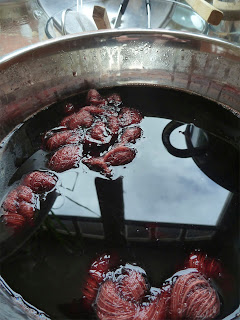This is a monster post, but I have so many things to report. We've had a bit of rainy weather, but that hasn't stopped me from dyeing. After my day with Myrtille, I managed to get some samples made from our little dye tests. Here are the samples.
 |
| Left to Right: Madder tops and roots, Cornelian cherry branches, Cornelian cherry flowers |
I was very happy to have found another good source of yellow dye. The flowers from the cornelian cherry are beginning to fade, but they'll be a welcome addition to the dye pot next year. They're one of the first things to flower in our area. Interestingly, the cornelian cherry is not a true cherry, but rather a member of the dogwood family. The fruits are edible, but are not very palatable. I've used them with blackberries to make a good jam.
 |
| Sample from cornelian cherry flowers. |
The wild madder tops and roots were interesting. I've got all kinds of ideas about how to make use of this wild plant. The sample is a lovely orange with a touch of red where the sample was in contact with the roots.

The cornelian cherry bark sample is a weak golden olive color, but bark usually takes a lot longer to give up good color. I'll try it again some other time.

Today I had one alum mordanted skein sitting in a bucket of rinse water and I thought I'd try a bit of bundling a la India Flint. I chose oak moss, Holm oak leaves and onion skins. I didn't want to have trouble picking out the vegetable matter later. I squeezed the excess water out of the skein, and laid it out on a nonreactive tray.
It took a little while to layer in all of the leaves, lichen and skins, but it was a lot of fun.

I used a bit of old cotton sheet to hold on a final layer before I tied it all up like a roast. I put the bundle in a steamer basket and steamed it for about 40 min. I turned it over once or twice while it was steaming.
 |
| The steamed bundle. |
I let it cool, and then I unwrapped it.

I think I was supposed to wait a day or two, but I couldn't help myself.


It was easy to pick out dye stuffs, even while wet. There were some very cool colors. The Holm oak leaves didn't seem to dye at all, but they may have reacted with the onion skins to leave some blue and green marks. Next time, I'll try freezing them before using them for contact dyeing.


This method was so much fun, and such a great way to get a painted look. I'm going to make a couple of dye concentrates to finish off this skein. The next time I do hot bundling, I'll try and leave them rolled up for a couple of days. Even the little piece of cotton cloth that I used to wrap up the bundle was dyed.

Last but not least, I've taken some pictures of my growing pile of naturally dyed skeins (BFL/nylon sock wool). They look so pretty all lined up together.
 |
| Left to Right: 2 skeins sage 1st bath, mushrooms, carrot tops 1st and 2nd bath, 2 juniper skeins, 2 skeins sage 2nd bath | | |
|
 |
| Left to Right: Sage, Mushrooms, Carrot, Carrot 2nd bath |
 |
| Holm Oak leaves first bath, Hellebore flowers 1st bath |
The Holm oak dyed skeins are my favorite.
 |
| Holm oak leaf dyed skein still wet from the bath. |
 |
| Holm oak leaf skein from the 1st bath. |
The fist bath is a warm chestnut color, and the second bath is almost as intense, but cooler in tone.
 |
| Holm oak leaf dyed skeins 1st and second baths. |
The first hellebore bath came out just like the sample.
 |
| Hellebore flower dyed skein, 1st bath. |
The exhaust bath produced a soft lemony skein.
 |
| Skeins drying. Second bath holm oak leaves and hellebore flowers. |
Next week I'll see if I can come up with some good greens.


























































